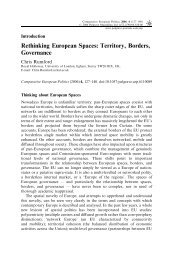Europeanisation, National Identities and Migration ... - europeanization
Europeanisation, National Identities and Migration ... - europeanization
Europeanisation, National Identities and Migration ... - europeanization
You also want an ePaper? Increase the reach of your titles
YUMPU automatically turns print PDFs into web optimized ePapers that Google loves.
86 Andrew Geddes<br />
<strong>and</strong> public policies (Edelman 1988). The result has tended to be the adoption of<br />
policy frames that organise or reorganise the conceptual <strong>and</strong> organisational<br />
boundaries of a given community (usually national) so as to include or exclude<br />
newcomers. This national point of reference has been particularly evident in ‘older’<br />
immigration countries in north-west Europe.<br />
The geopolitical <strong>and</strong> conceptual widening of international migration to include<br />
new countries <strong>and</strong> new types of migration causes some pause for thought <strong>and</strong> raises<br />
questions about these national frames of reference <strong>and</strong> their continued relevance.<br />
For instance, state contexts in southern, central <strong>and</strong> eastern Europe differ from<br />
those in older immigration countries. If state penetration of society is at a lower<br />
level then this could affect the capacity of states to affect ‘integrative’ outcomes.<br />
So too could the development of economic <strong>and</strong> political integration that creates<br />
rights that cross frontiers within the European Union. This then links to the ideas<br />
about the ‘neo-medieval’ EU developed by Zielonka (2001). For Zielonka, the<br />
term captures both the heterogeneity <strong>and</strong> boundary-changing nature/potential of<br />
the EU. It also indicates a development that both reflects this diversity <strong>and</strong> is<br />
normatively desirable.<br />
The argument of this chapter is that in a multiple <strong>and</strong> heterogeneous EU where<br />
there are some doubts about traditional underst<strong>and</strong>ings of integration centred<br />
on the welfare state then we also need to account for the role that legal certainty<br />
can play for immigrant, ethnic <strong>and</strong> national minorities. Such groups can be in a<br />
structurally weak position <strong>and</strong> thus vulnerable if a multiple <strong>and</strong> heterogeneous<br />
EU brings with it uncertainty <strong>and</strong> insecurity without the kinds of certainty imparted<br />
by anti-discrimination laws. It is argued that such laws are compatible with a<br />
vision of a multiple <strong>and</strong> diverse EU <strong>and</strong> indeed, that they are essential if all the<br />
peoples of Europe are to be given a sounder footing on which to advance claims for<br />
inclusion at local, national <strong>and</strong> EU level.<br />
Legal certainties in a neo-medieval Europe<br />
It is well known that there has been a rapid development of EU immigration<br />
<strong>and</strong> asylum responsibilities in the 1990s (Geddes 2000a). The EU has paid less<br />
attention to anti-discrimination laws, minority rights <strong>and</strong> action against racism <strong>and</strong><br />
xenophobia. This began to change in the 1990s, but often the only action taken<br />
was a ritual declaration appended to the conclusions of various summit meetings of<br />
the heads of government (European Parliament 1998). The result was that EU<br />
policy developments were lopsided in the sense that they focused on the control<br />
of those forms of international migration defined by state policies as unwanted, such<br />
as ‘illegal’ immigration <strong>and</strong> asylum seeking. Little attention was paid to issues<br />
relating to immigrant integration or the protection of minorities. The Treaty basis<br />
for such action was limited <strong>and</strong> these were seen as largely national concerns. If<br />
we employ the distinction made by Hammar (1990) then we can say that the EU<br />
has focused on immigration policies (concerned with the regulation of international<br />
migration in its many forms) rather than immigrant policies (addressed towards the<br />
social <strong>and</strong> legal position of migrants <strong>and</strong> minorities).



